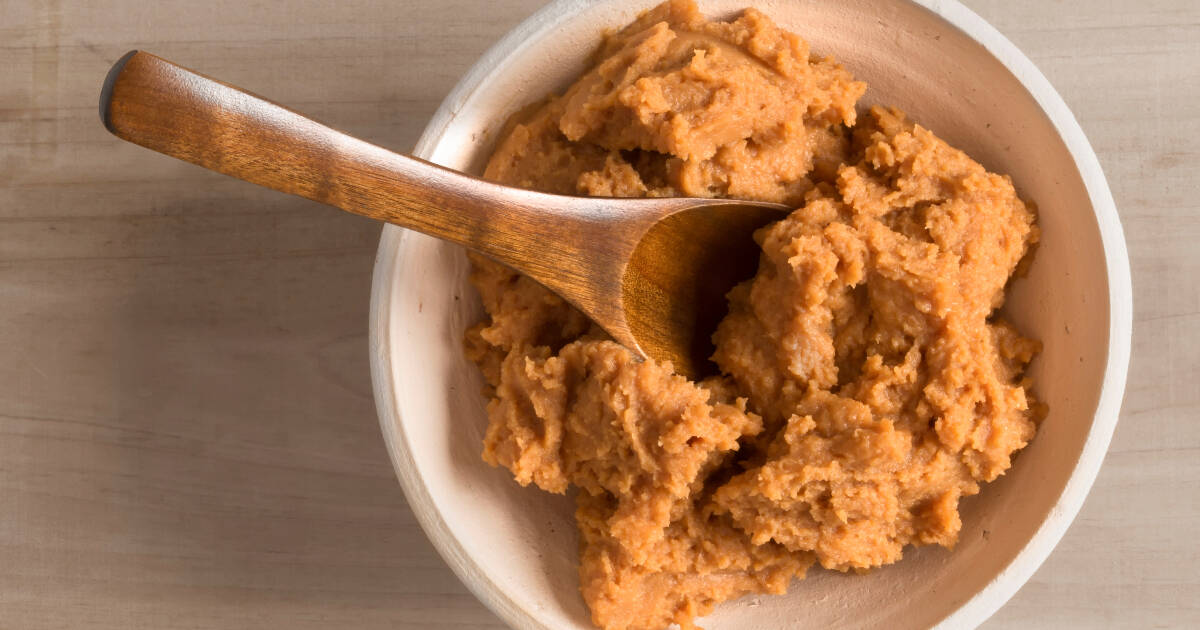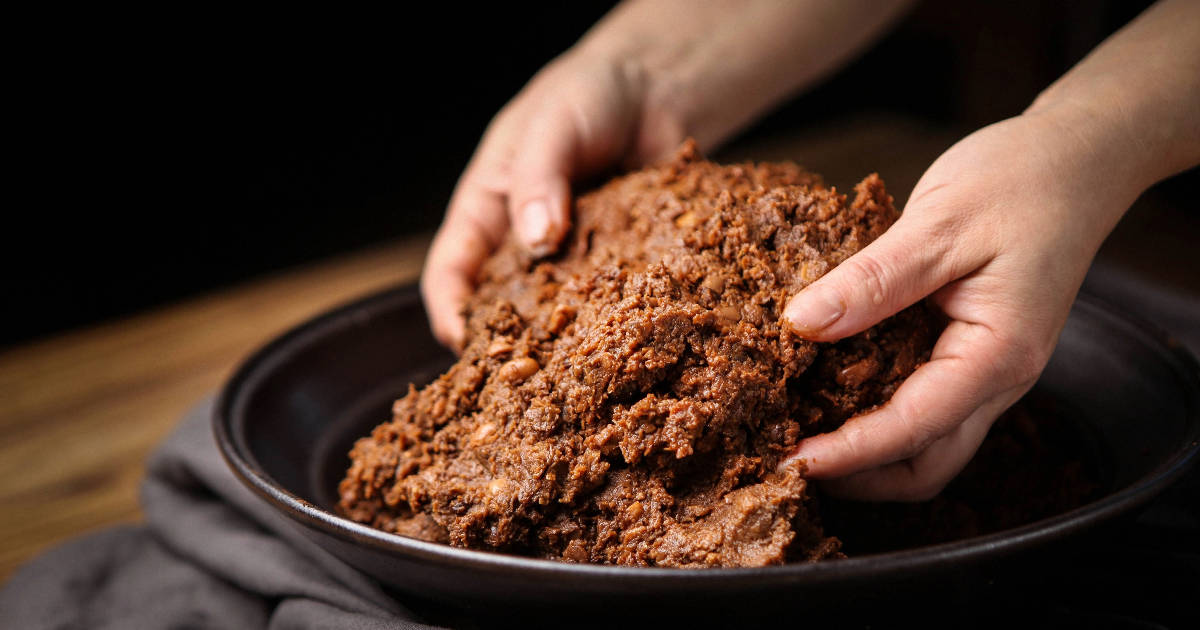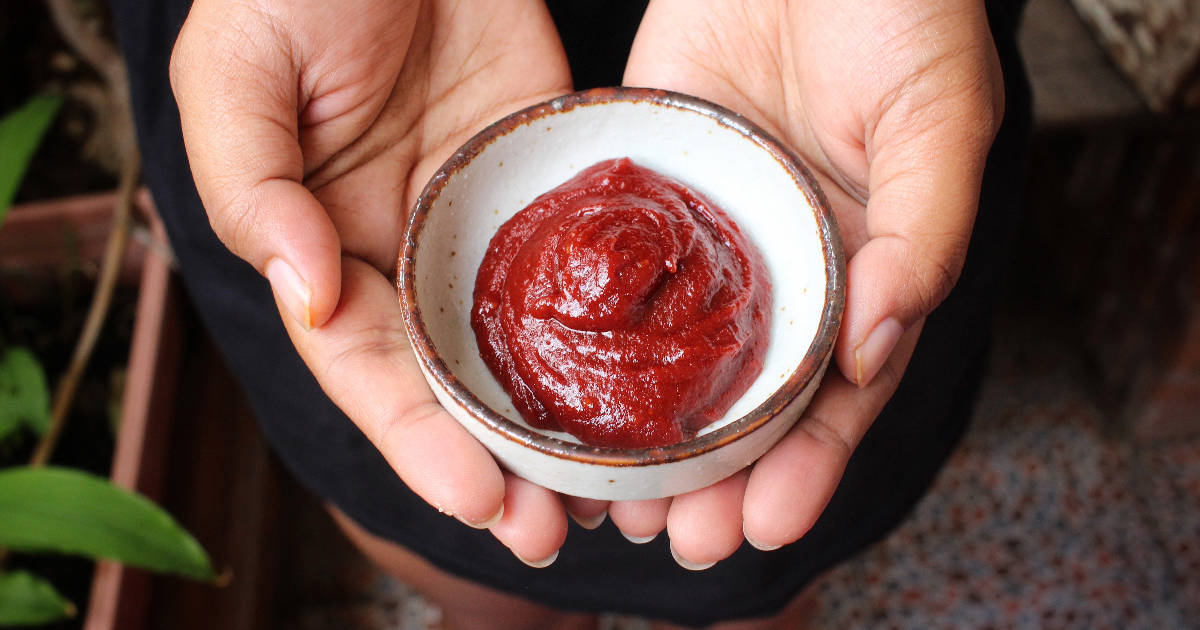Korean cuisine is renowned for its complex, savory flavors. Two of the most important ingredients that add a hearty umami taste and spice are the fermented pastes known as doenjang and gochujang.

Though often confused, doenjang and gochujang actually have very distinct tastes and uses in Korean cooking. We will compare and contrast everything you need to know about these two flavor powerhouses.
From their ingredients and flavor profiles, to how they are used in dishes, methods for substituting them, and how to buy and store them, you’ll learn why both doenjang and gochujang deserve a permanent spot in your pantry!
What is Doenjang?

Doenjang is a thick, salty, and pungent Korean fermented soybean paste. It has a deep umami flavor and is rich in protein, iron, and calcium.
Doenjang is made by fermenting soybeans that have been boiled, mashed, and shaped into blocks called meju. The meju blocks are left to ferment for several months, then placed in brine in earthenware pots to ferment further. After a year or so, the mixture naturally separates into a thin liquid used for soy sauce, and a thick paste that is doenjang.
The fermentation process gives doenjang its distinctive earthy, funky flavor that is quite strong. It adds a wonderful savoriness and depth to Korean stews, soups, marinades, dipping sauces, and more. A little bit goes a long way when cooking with doenjang!
What is Gochujang?

Gochujang is a savory, spicy Korean chili paste. It is made from chili peppers, glutinous rice, fermented soybeans, and salt that are aged together in pots for years. This long fermentation gives gochujang its characteristic deep red color, sticky texture, and complex sweet-spicy taste.
The main flavor notes in gochujang are heat from the chilies, sweetness from the glutinous rice, savoriness from the fermented soy, and saltiness. It adds heat, body, and bright character to many iconic Korean dishes. A small amount of gochujang really packs a flavor punch.
Key Differences Between Doenjang and Gochujang
Even though both are thick Korean fermented pastes, doenjang and gochujang are quite different in terms of their ingredients, taste, uses in cooking, and nutritional value. Here are some of the main ways they differ:
- Main ingredients: Doenjang is made from fermented soybeans, while gochujang contains chili peppers, glutinous rice, soybeans, and salt.
- Flavor profile: Doenjang is primarily salty, umami, and pungent. Gochujang is spicy, sweet, salty, and deeply savory.
- Color and texture: Doenjang is a pale brown paste with a coarse, chunky texture. Gochujang has a vivid red color and sticky, smooth texture.
- Heat level: Doenjang has no heat, while gochujang can range from mildly spicy to very hot depending on the amount and type of chili pepper used.
- Nutrition: Doenjang has more protein, as well as minerals like iron and calcium. Gochujang contains some vitamin A from the chili peppers.
- Uses: Doenjang is more versatile as a cooking ingredient, while gochujang is primarily used as a condiment or cooking sauce.
Doenjang's Unique Flavor Profile and Uses
The deep, complex flavor of doenjang comes from the long fermentation process which creates enzymes and amino acids that give it a strong umami taste.
Doenjang has a very distinctive funky, fermented aroma and earthy, savory flavor. The taste is primarily salty but also has subtle sweet and bitter notes. It is quite pungent and adds a wonderful heartiness to dishes.
Because it is so robust, doenjang is used more as an ingredient during cooking rather than only as a condiment. It melds beautifully into soups, stews, braises, rice bowls, dipping sauces, and vegetarian dishes:
- Doenjang jjigae: This classic Korean stew is made with doenjang, tofu, vegetables, and meat or seafood. The doenjang adds a rich, umami base.
- Ssamjang: A thick dipping sauce combining doenjang, gochujang, and other ingredients. It's served with ssam (lettuce wraps).
- Doenjang-marinated meat: Doenjang makes a great marinade for grilled meats, adding lots of flavor.
- Doenjang rice bowls: A scoop of rice topped with veggies, protein, eggs, and doenjang is a quick meal.
- Doenjang-seasoned veggies: Steamed or sauteed vegetables are tossed with a mixture of doenjang, garlic, and other seasonings.
- Doenjang pasta: This pungent paste can add a savory umami note to pasta sauces.
Because doenjang already has such a complex flavor, it usually doesn't need many other ingredients added to it in recipes. A little bit goes a long way.
Gochujang's Signature Spicy, Sweet Taste
Unlike doenjang, gochujang is known more for its chili pepper heat and sweetness from the fermented glutinous rice.
The specific flavors depend on the ingredients used, but in general, gochujang has a profile that is:
- Spicy and hot from the chili peppers - can range from mild to very fiery
- Sweet from the rice fermenting into sugars
- Salty from the salt added
- Umami from the fermented soybeans
- Slightly bitter from the fermentation process
This balanced combination of tastes makes gochujang very versatile as a condiment. It adds heat and savory depth to dishes without being overwhelmingly salty or sweet on its own.
The smooth, sticky texture and vibrant red-orange color also make gochujang visually striking. It is commonly used as a sauce or glaze rather than mixed directly into cooking:
- Bibimbap: Gochujang is stirred together with sesame oil and added on top of the rice and veggies.
- Tteokbokki: This classic snack is made from rice cakes simmered in a spicy gochujang sauce.
- Korean fried chicken: Gochujang flavors the sticky, savory sauce coating the fried chicken.
- Gochujang mayo: Adding gochujang to mayonnaise makes a great spicy condiment or burger spread.
- Gochujang meat: Thinly sliced meat like bulgogi can be marinated in gochujang for heat and sweetness.
- Gochujang aioli: Stirred into aioli, gochujang makes a fiery sauce for dipping fries or sandwiches.
Gochujang's flavor is very focused on chili heat, sweetness, and umami. It usually needs other ingredients like soy sauce, sesame oil, garlic, or ginger added to balance it out in recipes.
Nutritional Value and Health Benefits
Both doenjang and gochujang provide some nutritional value and potential health benefits. Here is how their nutrition profiles compare:
Doenjang is rich in protein, iron, calcium, and probiotics from the fermentation process. The proteins and amino acids create a strong umami flavor. Potential benefits include:
- High in protein - the soybeans provide many essential amino acids
- Iron supports healthy blood and energy levels
- Calcium helps strengthen bones
- Probiotics may improve digestion and immunity
- Soy isoflavones function as antioxidants
Gochujang contains vitamin A, vitamin C, carotenoids, and capsaicin from the chili peppers. The fermented rice and soy offer probiotics as well. Some of its nutritional highlights include:
- Vitamin A is important for healthy skin and eyesight
- Vitamin C promotes immune health and nutrient absorption
- Capsaicin may boost metabolism and have anti-inflammatory effects
- Carotenoids like beta carotene act as antioxidants in the body
- Probiotics support beneficial gut bacteria and digestion
So while both pastes provide some benefits, doenjang tends to be more nutrient-dense overall. But the two can nicely complement each other when used together in recipes like ssamjang.
Flavor Substitution Between Doenjang and Gochujang
Doenjang and gochujang have unique tastes, so they are not directly interchangeable in recipes. However, in a pinch, they can sometimes stand in for each other with a few modifications:
- Using doenjang instead of gochujang will leave out spiciness and sweetness. Add chili powder or red pepper flakes for heat, and a bit of sugar for sweetness.
- Substituting gochujang for doenjang will make the dish significantly spicier. Balance out the heat by adding soy sauce, miso, or fish sauce for extra umami.
- For dipping sauces and marinades that call for both, replace some of the mixture with sriracha or miso for extra punch.
- In soups and stews, substitute a tablespoon or two of one for the other, then tweak seasonings as needed.
- For bibimbap, using doenjang instead of gochujang will require adding chili flakes and honey to approximate the same profile.
- In tteokbokki, gochujang instead of doenjang will give it a much spicier kick, so add soy sauce and monitor for preference.
As you can see, while doenjang and gochujang are not exactly interchangeable, you can make it work by adjusting other seasonings and ingredients to compensate. Start with small amounts substituted and tweak the flavors as you go.
Which to Use in Specific Dishes
Here is a quick guide for when to use doenjang or gochujang in popular Korean recipes:
- Doenjang jjigae (soybean paste stew): Doenjang is the star flavor
- Kimchi jjigae (kimchi stew): Use gochujang for more heat
- Bibimbap: Gochujang sauce is iconic, but doenjang is an umami alternative
- Bulgogi meat marinade: Gochujang adds sweet heat; doenjang gives an umami base
- Tteokbokki (spicy rice cakes): Gochujang is traditionally used in the sauce
- Ssamjang (lettuce wrap sauce): Equal parts doenjang and gochujang is classic
- Korean fried chicken: Gochujang is the key ingredient in the sauce
- Namul (seasoned vegetables): Doenjang dressing is common
- Dipping sauce: Either doenjang or gochujang works depending on the preferred flavor
As a basic rule of thumb, use doenjang when you want a deep salty, fermented taste, and gochujang when you want sweet chili heat. But both pastes work well blended together in dishes like ssamjang too!
How to Buy and Store Doenjang and Gochujang
Both fermented pastes can be found at Asian grocery stores, well-stocked supermarkets, and online:
- Doenjang is sold in small plastic tubs or earthenware jars. Look for a brown color and coarse texture.
- Gochujang comes in plastic tubes, tubs, or squeezable tubes. Look for a vibrant red color and smooth, thick texture.
Once opened, it is best to store them:
- In the refrigerator
- In an airtight non-metal container
- For up to one year past the best-by date (they are preserved by fermentation)
- With a clean spoon each time to avoid spoilage
Doenjang and gochujang both tend to separate, with liquid rising to the top. Stir them well before each use for even distribution of flavors.
FAQ
Is doenjang the same as miso?
No, miso is Japanese and uses rice or barley with soybeans.
Is gochujang very spicy?
It can range from mildly spicy to very hot depending on the amount of chili.
What's the best way to use doenjang/gochujang?
Start with small amounts and adjust flavorings to balance them out.
What dishes use doenjang/gochujang?
Doenjang - stews, rice bowls, marinades. Gochujang - sauces, glazes, dipping sauces.
Can you substitute one for the other?
Yes, but the flavor won't be quite the same - adjust other seasonings to compensate.
How long does opened doenjang/gochujang last?
About one year past the best-by date if stored properly in the fridge.
What's the difference in nutrition?
Doenjang has more protein and minerals. Gochujang provides some vitamins and carotenoids.
Which is better for you?
Both provide some benefits, but doenjang tends to be more nutrient-dense overall.
How do you use up doenjang/gochujang?
Add to dressings, marinades, stir-fries, noodles, soups, stews, and sauces.
Conclusion
In the end, Korean doenjang and gochujang are two unique fermented pastes that both deserve a place in your pantry. Doenjang offers a deep roasted umami flavor, while gochujang brings sweet spicy heat.
Doenjang works its magic in stews, rice bowls, marinades, and veggie dishes. Gochujang stars in spicy dipping sauces, meat glazes, and anything that needs a chili kick. Though different, they complement each other beautifully in recipes like ssamjang.
When shopping, look for quality, well-fermented versions for the best and most authentic flavor. Store them properly in the fridge and they will keep for up to a year. Start experimenting with small amounts in your cooking to get familiar with how doenjang and gochujang can enhance your dishes!

